
Hans Rottenhammer the Elder stands as a fascinating figure in the transition between late Renaissance Mannerism and the burgeoning Baroque era. A German painter born in Munich in 1564, he forged a unique path by immersing himself in the artistic currents of Italy, particularly Venice and Rome, before returning to his homeland. He became renowned for his highly finished cabinet paintings, often executed on copper, which blended Northern precision with Italianate colour and composition. His work, primarily focusing on religious and mythological themes, found favour among discerning collectors and courts across Europe, making him a pivotal artist in the cultural exchange between Northern Europe and Italy at the turn of the 17th century.
Early Life and Artistic Formation in Munich
Hans Rottenhammer was born into a reasonably well-established Munich family in 1564. His father, Thomas Rottenhammer, held the position of a court stable master, suggesting a connection, albeit perhaps indirect, to the Bavarian court environment. This background may have provided some initial stability or exposure to the arts, although details of his earliest years remain somewhat sparse. His formal artistic training began in 1582 when he became an apprentice to the Munich painter Hans Donauer the Elder.
Donauer was himself a significant local artist, known for his work for the Bavarian court, including decorative schemes and history paintings. Under Donauer's tutelage, likely lasting until around 1588, Rottenhammer would have received a solid grounding in the prevailing South German late Renaissance style. This style often combined elements of local tradition with influences filtering in from Italy and the Netherlands. This foundational training provided him with the technical skills necessary for his future development, likely including drawing, composition, and the handling of pigments.
However, like many ambitious Northern artists of his generation, Rottenhammer recognized that the epicentre of artistic innovation lay south of the Alps. Italy, with its classical heritage and the revolutionary achievements of Renaissance masters, beckoned. Seeking to broaden his horizons and refine his art, he embarked on the transformative journey to Italy, likely around 1588 or 1589, setting the stage for the most defining period of his career.
The Venetian Crucible: Colour and Light
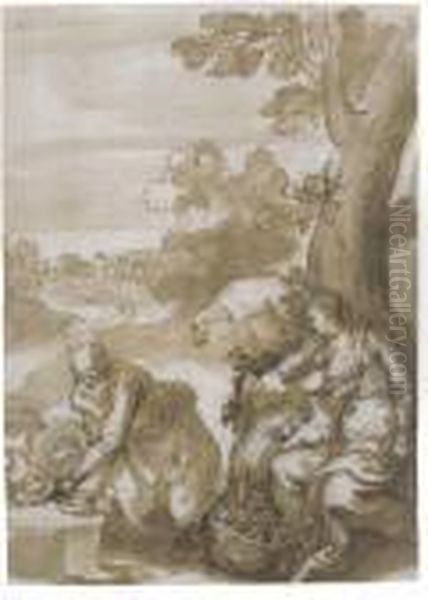
Rottenhammer's first major destination in Italy was Venice, the vibrant maritime republic renowned for its distinctive school of painting emphasizing colour (colorito) and light. Arriving around 1589, he remained there until approximately 1595 or 1596. This period proved immensely influential. He immersed himself in the study of the great Venetian masters, absorbing the lessons of Titian's successors who dominated the city's artistic scene.
He was particularly drawn to the dramatic compositions, rich palettes, and dynamic brushwork of Jacopo Tintoretto. The energy and emotional intensity of Tintoretto's large-scale narrative works left a clear mark on Rottenhammer's developing style, even as he adapted these influences to his preferred smaller formats. He also studied the opulent and decorative works of Paolo Veronese, whose mastery of complex figure groups and luminous colour harmonies offered another vital source of inspiration.
Furthermore, Rottenhammer would have encountered the work of Palma Giovane, another leading figure in late 16th-century Venetian painting, known for his prolific output and continuation of the Titianesque tradition. During his Venetian years, Rottenhammer began to specialize in the small, meticulously crafted cabinet paintings, often on copper, that would become his hallmark. These works, featuring mythological and religious subjects, combined the detailed finish associated with Northern traditions with the sensuous colour and light he absorbed in Venice. They quickly found a market among collectors and fellow artists.
Rome: Collaboration and Classical Themes
Around 1595 or 1596, Rottenhammer moved from Venice to Rome, the heart of the Catholic Church and a magnet for artists from across Europe. Rome offered a different, yet equally stimulating, artistic environment. Here, the emphasis was perhaps more on drawing and composition (disegno), rooted in the study of classical antiquity and the High Renaissance masters like Raphael and Michelangelo. The city was a hub of artistic activity, witnessing the late flowering of Mannerism alongside the emergence of the powerful new Baroque style spearheaded by artists like Annibale Carracci and the revolutionary Caravaggio.
Rottenhammer integrated smoothly into the city's cosmopolitan artistic community, particularly connecting with the significant contingent of Northern artists residing there. This period was marked by fruitful collaborations, most notably with the Flemish landscape specialists Paul Bril and Jan Brueghel the Elder. This partnership became a model of specialization: Bril or Brueghel would paint detailed landscape settings, often on copper panels, which would then be sent to Rottenhammer (sometimes back to Venice initially, later perhaps within Rome or via correspondence) for the addition of figures.
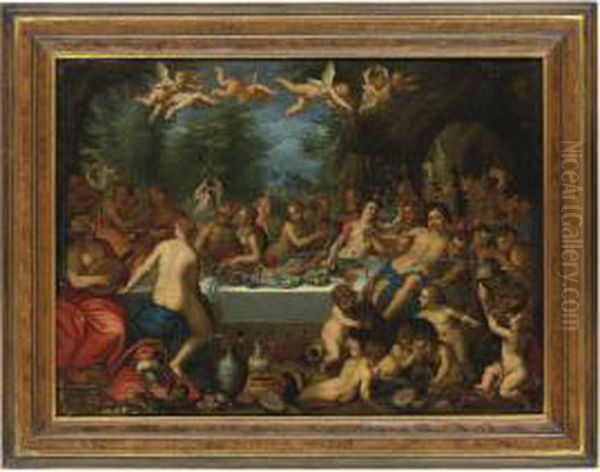
This collaborative method, where Rottenhammer provided the narrative focus within landscapes created by others, resulted in highly sought-after works. Famous examples include various versions of The Rest on the Flight into Egypt, where the Holy Family is delicately integrated into Bril's or Brueghel's lush settings. These collaborations highlight Rottenhammer's skill in adapting his figure style to harmonize with the detailed naturalism of his Flemish colleagues.
In Rome, Rottenhammer also formed a significant friendship with the slightly younger German painter Adam Elsheimer. Elsheimer, known for his own innovative small-scale paintings on copper that emphasized poetic light effects, likely benefited from Rottenhammer's experience and connections. Rottenhammer, in turn, may have been influenced by Elsheimer's sensitivity to light and atmosphere. This network also included interactions with artists like Frans van de Venne and Hendrick de Clerck, further enriching the exchange of ideas between Northern and Italian traditions. His Roman period saw him continue to produce mythological and religious cabinet pictures, increasingly informed by classical sculpture and Roman compositional principles.
Artistic Style: Mannerist Grace on Copper
Hans Rottenhammer's style is characterized by its synthesis of Northern European and Italian artistic traditions, primarily reflecting late Mannerism with emergent Baroque tendencies. His preference for painting on copper is central to his aesthetic. The smooth, non-absorbent surface of the copper plate allowed for an exceptionally high degree of detail and finish, lending his works a jewel-like quality. This suited the demands of the cabinet picture format, intended for close viewing in private collections.
His figures often display the elegant, elongated proportions and graceful, sometimes complex, poses typical of international Mannerism. Influences from artists like Bartholomäus Spranger or Hendrick Goltzius might be detected in the sophisticated artificiality of some figures, yet Rottenhammer tempers this with a softness and chromatic richness derived from his Venetian experience. His handling of flesh tones is often delicate and luminous, reflecting his study of Tintoretto and Veronese.
Compositionally, his works range from relatively straightforward narratives to complex, multi-figure scenes. In mythological subjects like The Feast of the Gods or Diana and Actaeon, he often populates the canvas (or copper plate) with numerous nude or semi-nude figures arranged in dynamic, interlocking groups. Religious scenes, such as The Last Judgement or depictions of the Holy Family, blend devotional sentiment with sophisticated artistry. He masterfully integrated his figures into landscape settings, whether his own or those provided by collaborators like Bril and Brueghel, ensuring a cohesive final image.
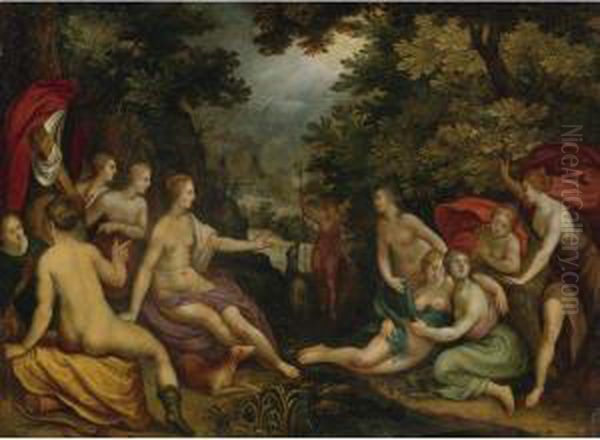
While rooted in Mannerism, his later works sometimes show a greater sense of dynamism and emotional intensity that anticipates the Baroque. The use of dramatic lighting, particularly in his Roman period and after, adds psychological depth and visual excitement. He was adept with various drawing media, using pen and ink, wash, and chalks to work out his compositions, showcasing a fluid and confident draughtsmanship that underpinned his painted works.
Signature Themes: Mythology and Religion
Rottenhammer's subject matter predominantly revolved around religious and mythological narratives, themes highly popular among the educated collectors and patrons of the late 16th and early 17th centuries. His repertoire drew heavily from the Old and New Testaments and from classical mythology, particularly Ovid's Metamorphoses. These subjects provided ample opportunity to depict the human form, explore complex narratives, and showcase his refined technique.
Religious themes included scenes from the life of Christ, such as the Nativity, the Baptism, the Crucifixion, and the Resurrection, as well as depictions of the Holy Family, the Lamentation, and numerous saints. The Last Judgement was a subject he returned to, allowing for grand compositions filled with figures in various states of salvation or damnation. These works often combined traditional iconography with his elegant figure style and rich colouring. His Rest on the Flight into Egypt, often painted in collaboration with landscape specialists, became one of his most frequently revisited and popular religious subjects.
Mythological scenes offered scope for depicting sensuous nudes and dramatic action. Popular subjects included The Feast of the Gods, Venus and Adonis, Diana and Actaeon, The Judgement of Paris, and various allegories. These works catered to the sophisticated tastes of collectors who appreciated the classical allusions and the often erotic undertones. Rottenhammer excelled at rendering the soft textures of flesh and the intricate details of drapery and setting within these mythological contexts. His ability to convey narrative clarity within often crowded compositions was a key strength.
Whether religious or mythological, his paintings were prized for their narrative richness, elegant execution, and decorative appeal. They functioned as objects of devotion, intellectual contemplation, and aesthetic pleasure, perfectly suited to the intimate setting of a private study or Kunstkammer (cabinet of curiosities).
Representative Works: A Glimpse into Rottenhammer's World

Several works stand out as particularly representative of Hans Rottenhammer's style and thematic concerns. His collaborations with Jan Brueghel the Elder and Paul Bril on various versions of The Rest on the Flight into Egypt are iconic. In these, Rottenhammer's gracefully rendered Holy Family provides the tender human focus within the meticulously detailed, jewel-like landscapes characteristic of his Flemish partners. The harmony achieved between figure and landscape in these small copper panels exemplifies the success of their international partnership.
The Feast of the Gods, a theme he painted multiple times, showcases his ability to handle complex, multi-figure mythological compositions. These works, often bustling with Olympian deities in various states of revelry and repose, demonstrate his absorption of Venetian colour and Mannerist figure types. They are vibrant, decorative, and filled with intricate details that invite close inspection.
His depictions of The Last Judgement, often ambitious compositions for their scale (though still frequently on copper), reveal his capacity for dramatic narrative. He marshals crowds of figures – the saved ascending towards heavenly light, the damned pulled down into darkness – displaying a compositional dynamism influenced by masters like Tintoretto, yet executed with his characteristic refinement.
Independent religious works like The Holy Family or The Lamentation over the Dead Christ highlight his ability to convey tender emotion and devotional piety. Even within the small format, he achieves a sense of monumentality and psychological depth. A work like The Sinking of Pharaoh's Army in the Red Sea demonstrates his skill in depicting dramatic action and large crowds within a historical-religious context. These representative pieces underscore his versatility, his technical mastery, especially on copper, and his successful fusion of Northern and Italian artistic elements.
Return to Germany: The Augsburg Years
Around 1606, after a long and formative period in Italy spanning roughly fifteen years, Hans Rottenhammer decided to return north. He chose to settle in Augsburg, a prominent Imperial Free City in Southern Germany known for its wealthy merchant class, skilled artisans (especially goldsmiths), and active art market. He arrived with his wife, Elisabetta di Fabris, whom he had married in Venice, and their growing family (eventually including five children).
In Augsburg, Rottenhammer enjoyed considerable prestige, recognized as an artist of international standing who brought the sophisticated Italianate style back to German soil. He received significant commissions, including larger-scale works like altarpieces for local churches and potentially for patrons beyond Augsburg. This marked a partial shift from the small cabinet pictures that had dominated his Italian period, although he likely continued to produce smaller works as well. His reputation attracted patrons among the city's elite and possibly from nearby courts.
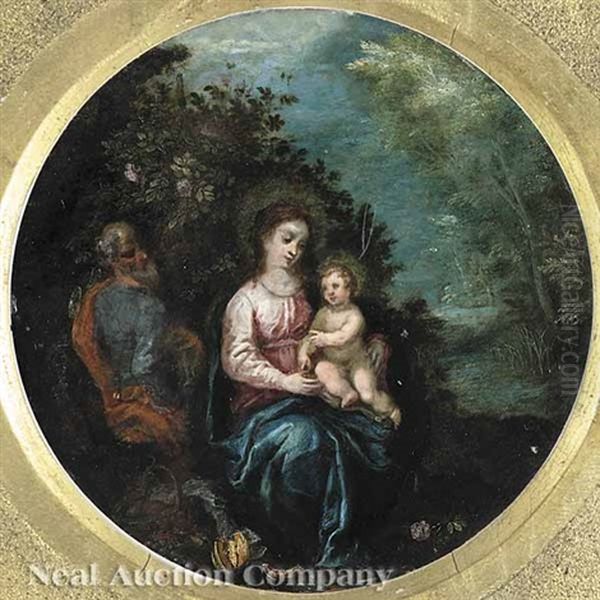
He became a leading figure in Augsburg's artistic life, influencing local painters and contributing to the city's cultural landscape. His presence reinforced the taste for Italian-inspired art in Southern Germany. His works from this period continued to show his characteristic blend of elegant figures and rich colour, though some scholars detect a slight coarsening or simplification in his later output compared to the peak refinement of his Venetian and Roman years.
Later Life: Challenges and Decline
Despite his initial success and esteemed position in Augsburg, Hans Rottenhammer's later years were marked by significant personal and professional challenges. Contemporary accounts and documents suggest that he increasingly struggled with alcoholism. This addiction severely hampered his productivity and reliability, leading to periods where he was unable to work effectively or fulfill commissions. His financial situation deteriorated as a consequence.
Adding to his difficulties, Rottenhammer also experienced problems with his eyesight. In a letter dating from around 1611, he himself admitted that his failing vision made it difficult, if not impossible, to continue executing the highly detailed miniature work that had been a staple of his output. This physical limitation, combined with the effects of his drinking, undoubtedly contributed to a decline in the quality and quantity of his work during his final decade.
These struggles cast a shadow over his final years. The artist who had achieved international recognition and successfully navigated the competitive art scenes of Venice and Rome found himself facing hardship in his homeland. Hans Rottenhammer died in Augsburg in 1625, reportedly in poverty, a poignant end for a painter of such talent and earlier success. Some questions regarding the attribution of works from his later period, or those associated with his workshop, may stem from these difficult circumstances.
Legacy and Influence: Bridging North and South
Hans Rottenhammer occupies an important place in the history of German and European art around 1600. His primary significance lies in his role as a conduit for Italian artistic ideas, particularly the Venetian colouristic tradition and Roman compositional structures, into Northern Europe. He was one of the most successful German artists of his generation to fully assimilate Italian styles while retaining a distinctively Northern sensibility for detail and finish.
His specialization in highly refined cabinet paintings on copper contributed significantly to the popularity of this genre among collectors across the continent. These small, precious objects were easily transportable, facilitating the spread of his style and reputation. His works entered numerous prestigious collections, including that of Emperor Rudolf II in Prague (though perhaps indirectly) and Cardinal Federico Borromeo in Milan, indicating his high standing.
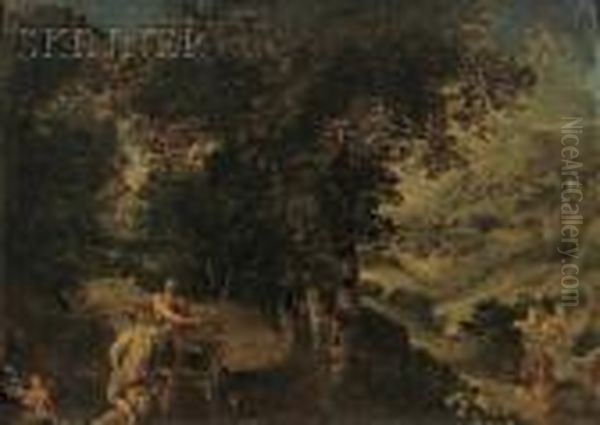
His collaborations with Paul Bril and Jan Brueghel the Elder were particularly influential, demonstrating a successful model of artistic partnership and contributing to the development of landscape painting by integrating sophisticated figure groups. His friendship and interaction with Adam Elsheimer in Rome were also crucial, likely impacting both artists' development. Elsheimer, who himself became highly influential, benefited from Rottenhammer's network and experience.
While his later years were troubled, Rottenhammer's earlier achievements ensured his legacy. He influenced subsequent generations of German artists seeking to engage with Italian art. His paintings are found today in major museums worldwide, including the Alte Pinakothek in Munich, the Kunsthistorisches Museum in Vienna, the National Gallery in London, the Rijksmuseum in Amsterdam, and the J. Paul Getty Museum in Los Angeles, attesting to his enduring importance. His auction records continue to reflect interest in his work, particularly his well-preserved paintings on copper.
Conclusion: An Enduring Synthesis
Hans Rottenhammer the Elder remains a key figure for understanding the complex artistic exchanges that characterized European art around the turn of the 17th century. His journey from Munich to Venice and Rome, and back to Augsburg, mirrors the path of many Northern artists seeking Italian inspiration. Yet, Rottenhammer achieved a particularly successful synthesis, blending the meticulous craft associated with the North with the colour, light, and compositional grandeur of Italy. His cabinet paintings on copper are testaments to this fusion, admired for their elegance, narrative richness, and jewel-like beauty. Despite the personal difficulties that clouded his final years, his work played a vital role in disseminating Italianate styles north of the Alps and left a lasting mark on the development of cabinet painting and artistic collaboration in the late Renaissance and early Baroque periods.